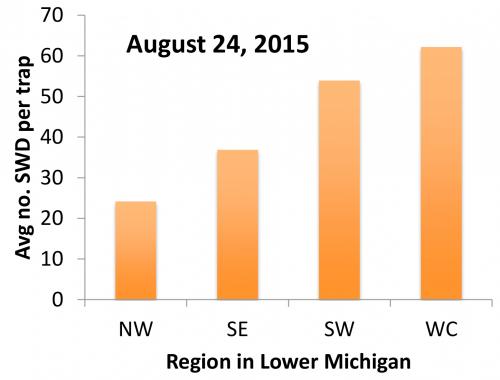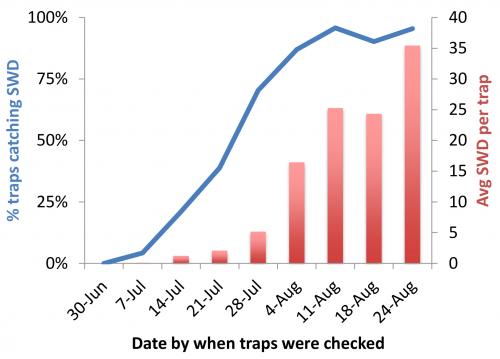Michigan spotted wing Drosophila report for August 25, 2015
High pressure from spotted wing Drosophila continues. Susceptible crops must be protected or risk infestation.
In the 11th week of monitoring spotted wing Drosophila (SWD), the summer increase continues with 95 percent of all of sites in the network reporting SWD in traps this week. The highest per trap average came from the west central region again this week followed by southwest and southeast. A big bump in SWD per trap came from the northwest this week as well. The total number of SWD caught this week was 30 percent higher than last week with 1,719 females and 2,180 males for a total of 3,899 captured in 105 out of the 110 traps.
There continues to be a high risk of fruit infestation by SWD throughout the state, so it is essential to maintain fruit protection on ripe or ripening susceptible fruit. Maintain coverage with effective insecticides, re-apply after rain, alternate among insecticides with different modes of action to reduce the risk of creating insecticide-resistant SWD populations and do not stretch your spray intervals too far.
If you are not using traps to monitor for adults of this pest, finding fruit that is softer than expected is a telltale sign of infestation by SWD in cherries, blueberries, raspberries and other thin-skinned fruit. Consult Michigan State University’s Spotted Wing Drosophila website where there are crop recommendations posted for berry crops, or contact your local Michigan State University Extension fruit educator.
A salt test is strongly recommended prior to harvest to help determine whether protective measures are working or if your management program needs to be adjusted. For instructions on how to conduct a salt test, please refer to the July 28 SWD report.
For instructions on how to construct your own traps and use them for monitoring for SWD, please visit the MSU Spotted Wing Drosophila website. For specific recommendations about managing SWD in berry crops, please see “Increase of spotted wing Drosophila in berry crops.”
The purpose of the Michigan State University Extension spotted wing Drosophila (SWD) monitoring network is to provide growers with regional trends in SWD population growth. Traps in the network are baited with Trece lures and placed near susceptible crops and wild hosts in each of the major fruit growing regions across the state. Commercial plantings include strawberries, blueberries, raspberries, grapes, tart and sweet cherries, peaches and plums. Wild hosts in the trapping network include autumn olives, black cherries, pin cherries, choke cherries, blackberries, honeysuckle, mulberries and wild grapes.

Average number of spotted wing Drosophila flies caught in traps in four Michigan fruit production regions. This week: NW = 67 traps in Antrim, Benzie, Grand Traverse, Leelanau and Manistee counties; SE = 8 traps across Ingham, Lenawee, Livingston, Monroe and Oakland; SW = 23 traps across Allegan, Berrien, Ottawa and Van Buren; and WC = 12 traps in Ionia, Kent and Oceana.

Average number of spotted wing Drosophila (SWD) captured per trap (red bars) and the percentage of traps that captured any SWD (blue line) across the entire trapping network by week starting June 30, 2015.



 Print
Print Email
Email

